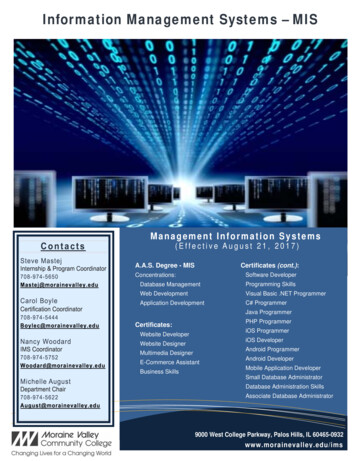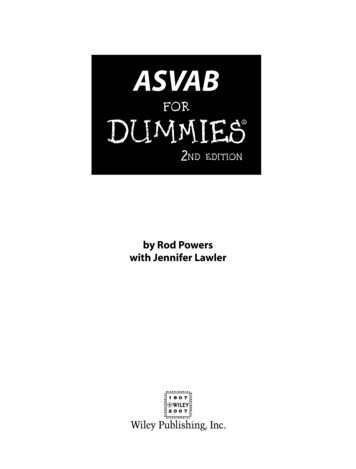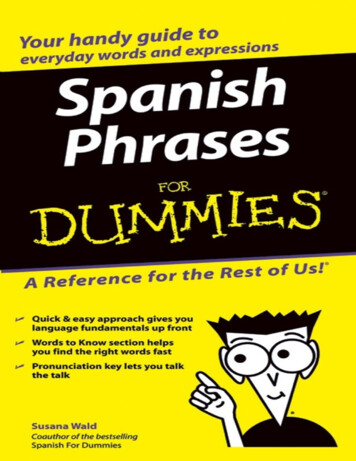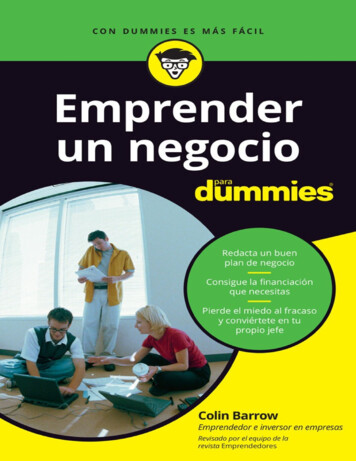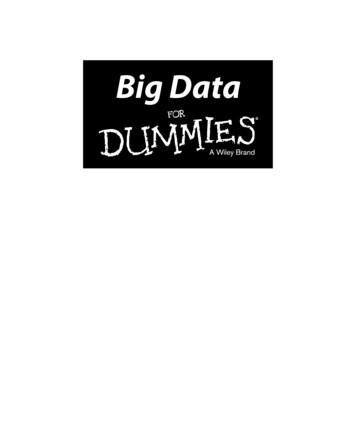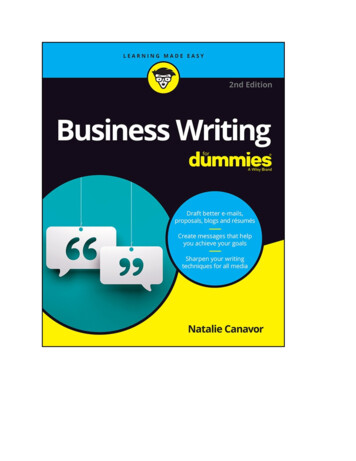
Transcription
Business Writing For Dummies , 2nd EditionPublished by: John Wiley & Sons, Inc., 111 River Street, Hoboken, NJ07030-5774, www.wiley.comCopyright 2017 by John Wiley & Sons, Inc., Hoboken, New JerseyPublished simultaneously in CanadaNo part of this publication may be reproduced, stored in a retrieval system ortransmitted in any form or by any means, electronic, mechanical,photocopying, recording, scanning or otherwise, except as permitted underSections 107 or 108 of the 1976 United States Copyright Act, without theprior written permission of the Publisher. Requests to the Publisher forpermission should be addressed to the Permissions Department, John Wiley& Sons, Inc., 111 River Street, Hoboken, NJ 07030, (201) 748-6011, fax(201) 748-6008, or online at http://www.wiley.com/go/permissions.Trademarks: Wiley, For Dummies, the Dummies Man logo, Dummies.com,Making Everything Easier, and related trade dress are trademarks orregistered trademarks of John Wiley & Sons, Inc. and may not be usedwithout written permission. All other trademarks are the property of theirrespective owners. John Wiley & Sons, Inc. is not associated with anyproduct or vendor mentioned in this book.LIMIT OF LIABILITY/DISCLAIMER OF WARRANTY: THEPUBLISHER AND THE AUTHOR MAKE NO REPRESENTATIONS ORWARRANTIES WITH RESPECT TO THE ACCURACY ORCOMPLETENESS OF THE CONTENTS OF THIS WORK ANDSPECIFICALLY DISCLAIM ALL WARRANTIES, INCLUDINGWITHOUT LIMITATION WARRANTIES OF FITNESS FOR APARTICULAR PURPOSE. NO WARRANTY MAY BE CREATED OREXTENDED BY SALES OR PROMOTIONAL MATERIALS. THEADVICE AND STRATEGIES CONTAINED HEREIN MAY NOT BESUITABLE FOR EVERY SITUATION. THIS WORK IS SOLD WITHTHE UNDERSTANDING THAT THE PUBLISHER IS NOT ENGAGEDIN RENDERING LEGAL, ACCOUNTING, OR OTHER PROFESSIONALSERVICES. IF PROFESSIONAL ASSISTANCE IS REQUIRED, THESERVICES OF A COMPETENT PROFESSIONAL PERSON SHOULD BESOUGHT. NEITHER THE PUBLISHER NOR THE AUTHOR SHALL BE
LIABLE FOR DAMAGES ARISING HEREFROM. THE FACT THAT ANORGANIZATION OR WEBSITE IS REFERRED TO IN THIS WORK ASA CITATION AND/OR A POTENTIAL SOURCE OF FURTHERINFORMATION DOES NOT MEAN THAT THE AUTHOR OR THEPUBLISHER ENDORSES THE INFORMATION THE ORGANIZATIONOR WEBSITE MAY PROVIDE OR RECOMMENDATIONS IT MAYMAKE. FURTHER, READERS SHOULD BE AWARE THAT INTERNETWEBSITES LISTED IN THIS WORK MAY HAVE CHANGED ORDISAPPEARED BETWEEN WHEN THIS WORK WAS WRITTEN ANDWHEN IT IS READ.For general information on our other products and services, please contactour Customer Care Department within the U.S. at 877-762-2974, outside theU.S. at 317-572-3993, or fax 317-572-4002. For technical support, pleasevisit ley publishes in a variety of print and electronic formats and by print-ondemand. Some material included with standard print versions of this bookmay not be included in e-books or in print-on-demand. If this book refers tomedia such as a CD or DVD that is not included in the version youpurchased, you may download this material athttp://booksupport.wiley.com. For more information about Wileyproducts, visit www.wiley.com.Library of Congress Control Number: 2017936222ISBN 978-1-119-36900-4 (pbk); ISBN 978-1-119-36901-1 (ebk); ISBN 9781-119-36903-5 (ebk)
Business Writing For Dummies To view this book's Cheat Sheet, simply go towww.dummies.com and search for “Business WritingFor Dummies Cheat Sheet” in the Search box.Table of ContentsCoverIntroductionAbout This BookFoolish AssumptionsHow This Book Is OrganizedIcons Used in This BookBeyond the BookWhere to Go from HerePart 1: Winning with WritingChapter 1: Make Writing Your Not-So-SecretWeaponPutting Good Writing to Work for YouPlanning and Structuring Every MessageApplying the Goal-Plus-Audience Strategy to All Business NeedsChapter 2: Planning Your Message Every TimeAdopting the Plan-Draft-Edit PrincipleFine-Tuning Your Plan: Your Goals and AudienceMaking People CareChoosing Your Written Voice: ToneUsing Relationship-Building TechniquesChapter 3: Making Your Writing Work: The BasicsStepping into Twenty-First-Century Writing StyleEnergizing Your Language
Employing Reader-Friendly Graphic TechniquesChapter 4: Self-Editing: Professional Ways toImprove Your WorkChanging Hats: From Writer to EditorReviewing the Big and Small PicturesMoving from Passive to ActiveSidestepping Jargon, Clichés, and Extra ModifiersChapter 5: Fixing Common Writing ProblemsOrganizing Your DocumentCatching Common MistakesReviewing and Proofreading: The Final CheckPart 2: Applying Your Skills to Business Messages andDocumentsChapter 6: Writing Messages That Get ResultsFast-Forwarding Your Agenda with EmailStarting StrongBuilding Messages That Achieve Your GoalsStructuring Your Middle GroundClosing StrongPolishing Your EmailGood Letter Writing TechniquesChapter 7: Creating High-Impact BusinessMaterialsCreating Valued ReportsFast-Tracking Your ProposalsWriting an Executive SummaryWriting Tips for All Business DocumentsPart 3: Writing to Present Yourself EffectivelyChapter 8: Speaking Well for YourselfBuilding Your Elevator SpeechPreparing and Giving PresentationsComposing Talking Points for Live InteractionChapter 9: Telling Your Business Stories
Finding Your Core Business MessageFinding, Shaping, and Using StoriesTelling Your Story with VideoChapter 10: Writing for the Job HuntKnowing and Expressing Your ValueWriting Résumés That Win the RaceSucceeding with Cover LettersNetworking with MessagesPart 4: Evolving Your Writing for Online MediaChapter 11: Writing for the Digital WorldPositioning Yourself OnlineStrategizing Your Platform ChoicesWriting for Digital MediaTranslating text into visualsChapter 12: Creating Your Online PresenceCreating a Website from the Ground UpCreating a BlogNetworking with TwitterWriting Online ProfilesUsing Social Media PlatformsPart 5: Extending Your Writing SkillsChapter 13: Writing and the Independent WorkerWriting Persuasively Cross-MediaIntroducing Yourself in WritingWriting to Pitch Your ServicesCreating Letters That SellWriting Difficult MessagesCommunicating as a Virtual WorkerPitching the MediaChapter 14: Writing Well to Manage WellCommunicating as a ManagerWriting to Higher-UpsWriting Backup Memos
Part 6: The Part of TensChapter 15: Ten Ways to Advance Your Career withWritingWrite to Build RelationshipsWrite a Great Elevator SpeechWrite Your Own Long-Range Career PlanWrite an Ad for Your Dream JobGo Out of Your Way to Thank PeopleTake Notes to Control the ConversationUse Social Media StrategicallyKnow How to Explain Your ValueProfile Your Higher-UpsCreate Talking PointsChapter 16: Ten Ways to Energize Your RésuméDon’t Apply for the Job You Have NowAdopt the Employer’s LanguageWrite Clearly and ConciselyCommunicate What You Actually DoWrite Narratives, Not Just BulletsSidestep Jargon and Business-SpeakUse Action Verbs to Prove What You AccomplishedWrite in a Confident, Positive ToneIncorporate KeywordsMake It Look GoodChapter 17: Ten Steps to Creating VideoKnow Your Goal, Know Your AudiencePlan Your Production Style and ContentWrite a Word Picture ScriptCreate a Shot ListLights, Action, CameraReview Your Shoot and Other ResourcesFind a Good LeadMatch Picture and WordsCraft the Right Words
Let Me Entertain YouAbout the AuthorConnect with DummiesEnd User License Agreement
IntroductionWriting was invented around 5,000 years ago, and the rest is well, history.Before writing evolved, people couldn’t record events or anything theylearned, so they had no means of sharing information other than in person.Without a way to build upon knowledge, people were limited by their ownexperience and what they learned from those immediately around them.Writing changed all that. With it, human beings created civilizations. But formany millennia, the rich governing classes owned the ability to both read andwrite. A few culture and technology revolutions later, and now we all ownthose powers. With a simple click you can share an opinion with the wholeworld. Reach decision-makers and influencers. Create a market for a productor service, or a community of followers or friends.One result of owning this magical power is that like Superman, you’reobliged to use it! More opportunities are open to you than any of yourancestors, even your parents. But because everyone has the power, whateveryour goals, competition is guaranteed. Whether you’re a job applicant, amanager who wants to rise, an entrepreneur who hopes to do it your way, aprofessional or a specialist of any kind, writing well is today’s imperative.If you’re reading this book, you already know that. But I think you’ll besurprised by how many more ways good writing can reward you than younow suspect. Good writers are increasingly at a premium in every industryand in every kind of enterprise. And everybody must write. It’s no longer aresponsibility that can be delegated to assistants or PR professionals. Nor is ita side task that most employees, entrepreneurs, or independent workers cansidestep.Today we all stand on our own: for everyday messaging that gets the jobdone, builds relationships, and prevents problems. For strong reports,proposals, and marketing materials that may be make or break events. Forplaying a role in the online world and using websites, blogs, networking sites,and social media to our advantage.Whenever a new communication medium emerges and we have more ways todeliver messages, the writing challenge grows. The Internet turns the worldsof journalism, marketing, public relations, advertising, and business-building
upside down. It’s all become “democratized” — one big open field. Theticket is good writing backed by strategic planning, or strategy backed bywriting. Properly seen, they are two sides of the same coin.About This BookI wrote this book to give you a high-stakes tool for accomplishing your owngoals and dreams. While I aim to show you how to think and writestrategically, the methods are totally pragmatic. Every idea and technique isready to use and fully demonstrated. I base everything on my own decades oftrial and error as a journalist, magazine editor, corporate communicationsdirector, and consultant. The methods I show you have been field-tested inhundreds of my workshops and courses for businesspeople, public relationsprofessionals, corporate communicators, and nonprofit leaders.This book gives you a complete foundation for effective business writing aswell as guidelines to instantly improve everything you write. I hope thefollowing chapters inspire you to keep improving, a process I see as anendlessly rewarding quest.Foolish AssumptionsDo you assume any of the following?Writing well is a talent you’re born with — or not.Improving poor writing is difficult.Good writing is defined by correct grammar and spelling “rules.”Expressing complex thought demands complex language.Writing dense copy with long words makes you look more intelligent andeducated.Visual media like video and images diminishes the need for writing well.Reserving your best skills for “important” material makes sense.Every one of these assumptions is false. I debunk all of them in this book. Fornow, the important truth is that you can write better, whether you need basicgrounding or are already a good writer and want to become better yet.
This book gives you down-to-earth, easy-to-use techniques. It does not giveyou grammar lessons. Many of the ideas and thinking processes are drawnfrom the toolkits of professional writers who in large part learn by long trialand error. I want to save you that time. My mission is to show you how toknow what to say and how to say it, whatever the challenge. I also leave youwith ways to recognize how to determine if you’re succeeding, and if not,how to fix the problems.
How This Book Is OrganizedAs the author, naturally I’m happy if you read the whole book in the sequenceI created for it and build your skills step by step. However, you can equallychoose to dip into chapters and sections as you need them or the spirit movesyou. Use the table of contents or index to find what you want and after you’rethere, you may see options for delving further into subjects elsewhere in thebook.I organize the book into six parts.Part 1: Winning with WritingThis part gives you the whole groundwork for writing everything well.Discover a planning structure that helps you strategize your message in everymedium and a set of techniques for writing it the best possible way. Applypractical approaches to edit and revise your own work, which empower youto fine-tune your writing and enjoy the process more.Part 2: Applying Your Skills to Business Messagesand DocumentsEmail and letters remain important communication staples. Everydaymessaging helps you build your business relationships and professional imagewhile accomplishing your day-to-day goals. More formal business materialslike reports and proposals can be turning-point opportunities. This part showsyou how to identify your own writing problems and correct them, andpractice a thinking structure that lets you find your best content every time.Part 3: Writing to Present Yourself EffectivelyStrategic thinking based on writing helps you succeed in person as well as inmedia. This part shows you the how-to you need to create effective elevatorspeeches and presentations, find and craft your personal story, produce video,and develop talking points to guide you in face-to-face situations, plus tipsand techniques for the job hunt: résumés, cover letters, and networkingmessages.Part 4: Evolving Your Writing for Online MediaContent is king but today’s online reader and consumer have infinite
choices, and you need your contributions to engage quickly and deliversubstance. Writing is the cornerstone of online media. This part shows youhow to adapt your writing style for digital readers, adopt effective techniques,and plan and build blogs and websites. This part also shows you how tocreate a social media program to build your audience, reputation, authority,and networks.Part 5: Extending Your Writing SkillsBoth in-house workers and independents — business owners, consultants,and freelancers — benefit from thinking like entrepreneurs. This part coversthe tools of persuasion, marketing yourself, pitching the media,communicating with teams and bosses, and writing tough messages whenyou’re the boss.Part 6: The Part of TensMany readers find this section the most fun section of the For Dummies bookseries. Look here for ten punchy ideas to advance your career with writing,how to produce quality video, and how to energize your résumé.Icons Used in This BookTo help you focus on what’s most important and move it into memory, look tothe icons.These are practical ideas and techniques you can put to workimmediately — and amaze yourself with good results!This icon keys you in to guidelines and strategies to absorb and usefor everything you write.This icon signals thin ice, don’t take the risk! Observe these cautions
to avoid endangering your business, image, or cause.You’ll also find sections that begin with, Try This:. Why leave all the workto me? Take these opportunities to try your own hand or apply an idea.Nothing builds your skills like practice — and I think you’ll enjoy it, and feelmore confident.Beyond the BookIn addition to what you’re reading now, this book also comes with a freeaccess-anywhere Cheat Sheet that gives you even more pointers on how towrite effectively in the business world. To get this Cheat Sheet, simply go towww.dummies.com and search for “Business Writing For Dummies CheatSheet” in the Search box.Where to Go from HereStarting at the beginning gives you a foundation that applies to everythingyou write. But if you prefer diving right in for help on a specific challenge, byall means do so. The advice may suggest other sections for more depth andyou can follow up as you choose.Everyone learns differently. Grown-ups enjoy the advantage of knowing theirown learning style. Furthermore, we all have our own writing problems torecognize and address. I tell you freely that I have my own, and many of theexamples of transforming blah wording to a more powerful version comefrom editing my own first drafts. To be most useful, I offer choices —different ways to identify problems and improve everything you write.Build a personal repertoire of techniques that work for you, then take thistoolkit on the road with you. Doing so brings you a more successful journey,new confidence, and a lot more fun along the way.
Part 1Winning with Writing
IN THIS PART Learn the core elements of good business writing to solve your mostpressing communication challenges.See how a goal-plus-audience strategy will never fail you, no matterhow hard the writing challenge seems.Learn how you can make people care about your message byconnecting with your reader, highlighting the benefits, and showingthem “what’s-in-it-for-me.”Understand how to write for readability and impact in today’s businessworld using the tools of writing — words, sentences, and structure —to say what you mean in a way most likely to earn respect, support,and agreement.Learn how to switch into the editor’s role and fix common writingproblems so that your messages accomplish what you want.
Chapter 1Make Writing Your Not-So-SecretWeaponIN THIS CHAPTERRising above the pack with good writingUnderstanding the three imperatives of strategic writingUsing an easy structure to plan everything you writeWriting successfully for print, online, visual, and spoken mediaDelivering your message well and being heard. What could be moreimportant in today’s world of over-communication?If your career ladder involves applying for jobs, you need strong résumés,letters, and face-to-face skills. To earn a promotion, your everydaycommunication must signal your reliability, judgment, and resourcefulness. Ifyou run your own business, or work as a consultant or other professional, Ibet your success depends on proposals and presentations. And today,whatever our aspirations, most of us want to create an effective onlinepresence. We want to team successfully with others and advocate for our ownneeds and ideas.The foundation for all of this, of course, is writing! Surprisingly fewpeople realize this. When they think about polishing their communicationskills, most people jump straight to presentations. Knowing how to give agood speech may seem sexier than writing, but it leapfrogs past the reality:Even a 20-second elevator pitch needs to be written before it’s spoken. Goodwebsites, videos, Twitter campaigns, blogs, and most other communicationtools start with the written word.There’s a simple reason for this. Human beings think in language. No matterhow big a role visuals play in a communication “product,” whether print ordigital, writing provides the indispensable support structure for planning. And
if even a few words appear in the ultimate message, they must be just theright ones.In this chapter, I highlight the core elements of good business writing andintroduce a planning structure that enables you to figure out what to say andhow to say it in just about every circumstance. This step-by-step approach towriting works for every communication platform with just a little adaptationfor each one. You’ll find that improving your writing offers even morebenefits than you may suspect, and that you’ve already begun to build thefoundation for it. In later chapters, I show you how to apply these ideas to allyour business communication.Putting Good Writing to Work for YouCan you imagine building relationships without language? Today we initiatemost relationships — especially in business — through the written word. Inperson contact may follow, or it may not. When the first contact is successful,we continue to rely on writing to build the connection and collaborate.From everyday email to reports, letters, and digital platforms, today’sworking world runs on writing. Therefore, the rewards of good writing havenever been more extraordinary. The Internet enables us to reach beyond ourpersonal geographic and social reach to almost anyone we want to sell to,collaborate with, or learn from. Almost anyone with time and dedication canstart a business and sell a product or service, post her artwork, publish a book,or establish his authority as an expert on a subject.There’s just one catch. Because anyone can do this, unless you are a narrowspecialist, the competition is overwhelming.Consider these statistics:112.5 billion business email messages are sent daily. (That’s 122messages per user!)There are 130 million active Twitter users, and 303 million tweets per dayare sent.The Internet holds 1 billion websites.There are 300 million blogs.
Of course, you’re not competing with all of these email messages, tweets,websites, and blogs, or reading more than an infinitesimal fraction of themyourself in each medium. But people today — just like you — are extremelyselective about what they choose to read because so many options vie fortheir attention.There are few captive audiences in today’s world. Check how manymessages you’ve recently received that you must read. Even if you holdtop-down authority, there’s no assurance that your message will be read.Attention, along with respect, must be earned. Writing a message thatsomeone will actually read is an achievement. Writing messages thatpeople will act on demands not just writing that is clear and direct, butalso content that is well thought-out and framed to the reader’s ownperspective. In other words, today’s business writing needs to bestrategic.What is strategic writing? Planned communication that achieves a set ofgoals — your goals, and often the goals of your employer and clients. Thegood news is that you already have a solid base for knowing how to writestrategically. You’re in command of the three imperatives:Your subject: You are invested in your field and possess in-depthknowledge of it.Your audience: You know who your audience is, such as prospectiveemployers, coworkers, and target markets for your business.Your goal: You know what you want, now and in the bigger-picturefuture.Here are some of the things you may not know yet:How to choose the right communication tool for the jobHow to capture and retain reader attentionHow to make people care about your messageHow to select the right content to make your case
How to use writing techniques that make your material persuasive andconvincingHow to use every single thing you write to build relationships andadvance your causeHow to understand other people’s perspective and predict their responsesHow to sharpen your ear and eye so you can spot your own writingproblems and fix themI show you how to do all these things in this book.Notice that almost every item in this list relates to the thinking part ofwriting, not the technical part. Master the art of thinking your contentthrough and you move way ahead of the competition. But of course, thetechnical side of writing — how you use language — matters, too. Icover that as well. You’ll find a whole resource of practical tips forimproving your sentences, word choice, and organization. Instead ofgrammar lessons, I give you a broad resource of practical tips forimproving your sentences, word choice, and organization. Try them outand discover the techniques that work best for you.Let’s start with a planning structure that will help you figure out what youwant to say and how to say it. You may be surprised at how much better yourmessages are received, and how much more often you get a positive response,once you start applying it.Planning and Structuring EveryMessageFaced with a blank page and something to accomplish, many people freeze atthe first question: Where do I start? The answer? Start with the threecomponents of strategic writing. You already know them:Your subject: What you’re writing aboutYour audience: Whom you’re writing to
Your goal: What you specifically want to accomplishTo create a good message and get the result you want from your reader, youneed to think about all of these things more systematically than you ordinarilymight.You must “read” your audience in an organized way — I show youhow. And you benefit from visualizing your goal in a broad way.Consider that for almost every message you write, you actually have awhole set of goals beyond the immediate: communicating your ownprofessional image, for example. When you combine your knowledge ofthe audience with your set of goals, it becomes easy to translate whatyou know about the subject into content that supports your message.For example, suppose you want to ask your supervisor for a plum assignmentyou see on the horizon. You can simply write:Jane, I’d like to present myself as a candidate for the lead role on theCrystal Project. You know my work and qualifications. I’ll reallyappreciate the opportunity, and I’ll do a great job. Thanks, JakeThis is maybe okay insofar as it’s clear and contains no obvious errors. Butit’s definitely not compelling. All Jane learns from the message is that Jakewants the opportunity and thinks he’s qualified.Jake would fare better if he first looked at his own goals more in depth.Perhaps he wants a chance to:Exercise more responsibilityShow off his capabilities and be noticedExpand his know-how in regard to the project’s subjectAdd a management credential to his résuméBut he also has the longer term to consider. Jake almost certainly will find ituseful to:
Strengthen his position for future special assignmentsRemind his boss of his good track recordBuild his image as a capable, reliable, resourceful leaderBuild toward a promotion or higher-level job in his current organizationor elsewhereFrom this vantage point, Jake can see the pitch itself as a building block forhis overall career ambitions, which calls for a better message than theperfunctory one he dashed off. He must think through the actual assignmentdemands and how his skills match up. Then there’s Jane — his audience — toconsider. What qualifications does she, the decision-maker, most value? Whatdoes she care about?After some thought, Jake may come up with a list like this:Job requires: Planning skills; ability to meet deadlines; knowledge ofXYZ systems; experience in intra-departmental coordination; goodjudgment under pressureJane values: Collaborative teaming; people skills; department reputation;effective presentation. She is weak in systems planning and insecure withnew technology.This bit of brainstorming helps Jake produce a blueprint for persuasivecontent. His email can briefly cite his proven track record in terms of the jobrequirements, his ability to deliver results as a team leader, his awareness thatsuccess will enhance the department’s reputation, and that he’ll use hisexcellent presentation skills to ensure this result.The weaknesses he pinpoints for Jane give Jake another avenue for presentinghimself as the best choice. He can suggest a planning system he’ll use tomake the most of staff resources and/or a specific way to incorporate neweasy-to-use technology. These aspects of his message are likely to catchJane’s attention.All Jake’s points must be true, needless to say. I don’t suggest ever
making up qualifications, but rather, that you take the trouble tocommunicate the best of what is real and what matters in a particularsituation.Further, never assume people understand your capabilities orremember your achievements, even if they’re colleagues who know youwell. Other people don’t have time to put you in perspective. They’rethinking about themselves. That’s why doing it yourself has such power.Even if Jake doesn’t get the assignment, writing a good email contributes tohis longer-range goals of presenting himself as ready, willing, and able to takeon new challenges and to be seen as more valuable.What Jake’s message illustrates is how to use a simple structure foreverything you write. My shorthand for this is simply Goal Audience Content. When you define what you want to accomplish with aspecific message, and think about the specific person you’re writing to,content decisions help make themselves.When you use this structured thinking to plan your messages, whether they’reemail messages or proposals or anything in between, you move far toward thereal heart of good writing — real and relevant substance. Writing is not asystem for manipulating words, and don’t ever expect it to camouflage a lackof thought, knowledge, or understanding. Good writing is good thinkingpresented clearly, concisely, and transparently in ways that make sense toyour readers.I make you a rash promise: For every fraction you improve your writing,you’ll improve your thinking along with it. Plus, you will improve yourability to understand other people, which will help you build betterrelationships and achieve what you want more often.Chapter 2 gives you an in-depth demonstration of this planning
structure and shows you how to translate it into successful messages.While you may pick and choose which sections of the book to read anddraw upon them at need, I encourage you to invest in Chapter 2. It givesyou the entire foundation for deciding what to say in any circumstance.Remember that the ideas apply equally to communications that appear tobe dominated by visuals or spoken language.The other essential groundwork for successful writing is how to say what youwant. Chapters 3, 4, and 5 demonstrate common-sense techniques thatprofessionals use to spot problems and fix them with the least effort.Try This: To quickly upgrade anything you write, use the say-it-alouddiagnosis. When you read your own copy aloud (or whisper it to yourself ifyou’re not alone), you get immediate signals that something isn’t working orcan work better. You may be forcing your sentences into a sing-song cadencethat denotes awkward construction, unnecessary words, and overly longsentences. You may hear repetitive sounds or inappropriate
Business Writing For Dummies To view this book's Cheat Sheet, simply go to www.dummies.com and search for "Business Writing For Dummies Cheat Sheet" in the Search box. Table of Contents Cover Introduction About This Book Foolish Assumptions How This Book Is Organized Icons Used in This Book Beyond the Book Where to Go from Here

